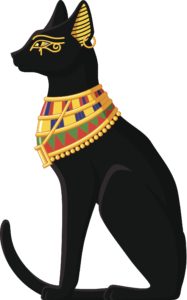
Domesticated felines have shared our lives and homes for most of human history. Of course, there’s the popular joke that they were worshipped as deities in Egypt and have never forgotten it since. All jesting aside, these four-legged friends hold a special place in our hearts. At the same time, it’s easy to forget that humans throughout history have ascribed religious and spiritual meanings to these graceful and mysterious creatures. Here is a breakdown of the historical religious significance of cats.
Felines Among the Gods
Probably the most famous cat deity is Bastet, a goddess in ancient Egypt’s pantheon. Depicted as a woman with a cat’s head, this divine being’s dominion included the hearth and home, women’s secrets, and cats, as well as serving as a protector against evil spirits and disease. The Ancient History Encyclopedia states that the city of Bubastis was her ritual center, with a huge temple built there in her honor. This reverence also extended to the ancient Egyptians’ treatment of their felines. It was not uncommon to shave one’s eyebrows in mourning if a household cat died, and cats were frequently rescued first during house fires. One extreme example comes from the Persian conquest of Egypt in 525 B.C., when Persian soldiers painted cats on their shields and held cats in their arms while marching into the city of Pelusium. The shocked Egyptians surrendered, probably in horror at seeing their beloved animals used against them by their enemy.
While ancient Kemet is likely the most outstanding example, cats have been highly regarded in other civilizations. The Chinese goddess Li Shou appeared in cat form, and the culture’s legends stated that the gods granted dominion to felines over the world shortly after its creation. The Encyclopedia Britannica reveals that Freyja, the Norse goddess of love, fertility, battle and death, was conveyed in a chariot pulled by cats. Besides Li Shou and Freyja, many more examples of feline or feline-loving deities can be found from the ancient world.
Cats as Witches’ Familiars
Prior to the widespread Christianization of Europe, Irish and Scottish people believed that cats were magical. While they regarded this trait as beneficial, the Ancient History Encyclopedia disclosed that the Catholic Church branded witches and their feline familiars as evil. Moreover, the “Vox in Rama” papal bull said to have been written by Pope Gregory IX in the early 1230s attempted to draw a link between cats and the Devil himself. The World Library’s article on “Vox in Rama” discloses that scholars still question the document’s authenticity, but the damage was already done. As a result, the regular killing of felines by superstitious people occurred throughout Europe during the Middle Ages in tandem with the religion-motivated murders of suspected witches.
Meanwhile, some modern witchcraft and pagan movements have embraced the idea of magical familiars. Pantheos contributor Jason Mankey describes this contemporary view of the cat as a “natural magickal assistant” who lends energy to ritualistic or magical endeavors. While some in medieval Europe believed that familiars were shape-shifting spirits who took on animal form, modern practitioners tend to see their felines as having a unique psychic sensitivity that makes them especially suited to the magical, spiritual or psychic work they perform.
Felines and Humans: A Natural Partnership
Humans and felines have a long-standing relationship that’s almost as old as the Holocene epoch itself. Scientists and historians theorize that this partnership began around 14,000 years ago, with cats being domesticated alongside sheep, goats and dogs. Over time, we’ve seen them as gods, celestial servants, supernatural guardians and even spirit guides. Unfortunately, we’ve also vilified them as enemies. With the advent of contemporary pagan traditions and other social changes, the negative connotations are slowly fading. Although it’s uncertain if anyone will worship these little creatures again, they continue to remain with us as valued companions and spiritual assistants.

